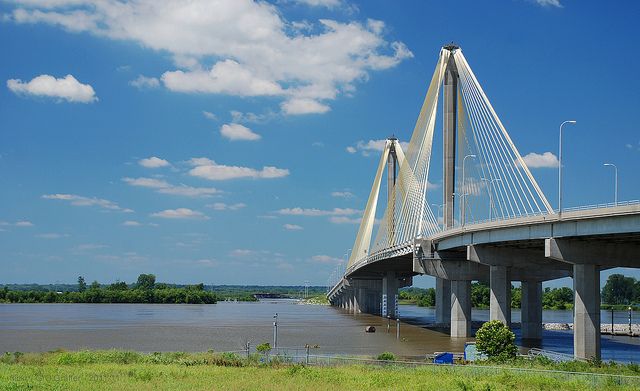 The Clark Bridge, linking Illinois to Missouri in Alton, is a cable-stay bridge, unique in its structure in the United States. The bridge is named for explorer William Clark, who helped lead the Lewis & Clark expedition from 1804 to 1806. The bridge is a 4,620 foot gateway inviting visitors to discover the region.
The Clark Bridge, linking Illinois to Missouri in Alton, is a cable-stay bridge, unique in its structure in the United States. The bridge is named for explorer William Clark, who helped lead the Lewis & Clark expedition from 1804 to 1806. The bridge is a 4,620 foot gateway inviting visitors to discover the region.
Requiring 8,100 tons of structural steel, 44,100 cubic yards of concrete and more than 160 miles of cable wrapped with four acres of yellow plastic piping, the Clark Bridge is expected to be a part of the area's scenery well into the next century. The bridge is supported by 44 steel cables looped over saddles and perched on top of a pair of ten foot wide concrete pylons 250 feet above the Mississippi River.
Design work on the bridge began in 1985, with construction starting in June 1990. Designed by Hanson Engineers under contract to Illinois Department of Transportation, the Clark Bridge was the first in the United States in which a light steel-framed cable-stayed design was combined with a cable saddle type of pylon. The bridge used 8,100 tons of structural steel, 44,100 cubic yards of concrete, and more than 160 miles of cable wrapped with four acres of yellow plastic piping. The span carries four lanes of traffic and two additional paths for bicycles and pedestrians. It is the northernmost river crossing in the St. Louis metropolitan area.
The new Clark Bridge was built to replace the Old Clark Bridge, which was built by the Alton-St. Louis Bridge Company in 1927 and demolished after the completion of the new bridge in the 1990s. The old bridge was a toll bridge while the new one is not.
The new Clark Bridge is sometimes referred to as the “Super Bridge.” Its construction was featured in a NOVA documentary entitled Super Bridge, which highlighted the challenges of building the bridge, especially during the Great Flood of 1993.



